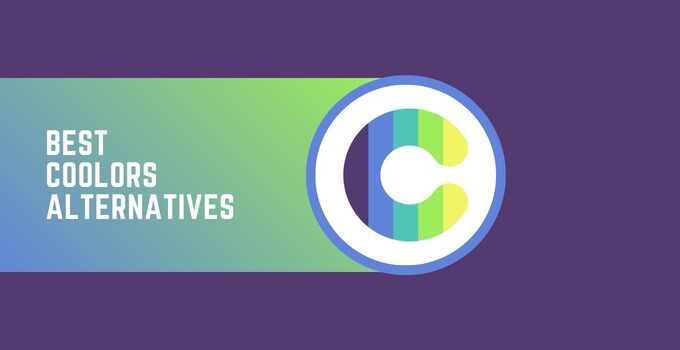Software Reviews & Alternatives for Coolors:
You’ve probably heard of Coolors if you have a passion for design. A tool for building and accumulating colour palettes is called Coolors. The app is the best among all different kinds of designers. It is utilised throughout a wide range of design fields, such as graphic design, user experience design, interior design, game design, brand design, etc.
The process of creating a colour palette is substantially facilitated by coolors. On your design adventure, you’ll discover that more is required than just Coolors.
Instead of being a serious creative tool, colours sometimes resemble games. It can feel unfocused even though clicking the spacebar to create arbitrary colour schemes is entertaining and occasionally successful.
Noting that Coolors was founded less than ten years ago is also important. Despite the fact that this makes the app highly unique, it offers less customization options than programmes developed by more reputable companies.
The ads may also make the free edition of Coolors feel a little cluttered. You must pay a $3 monthly subscription fee in month to use Coolors Pro, the version without advertisements and with full features.
People typically look for alternatives as a result of all of these considerations. The greatest Coolors substitutes will be covered in this article.
1. Paletton
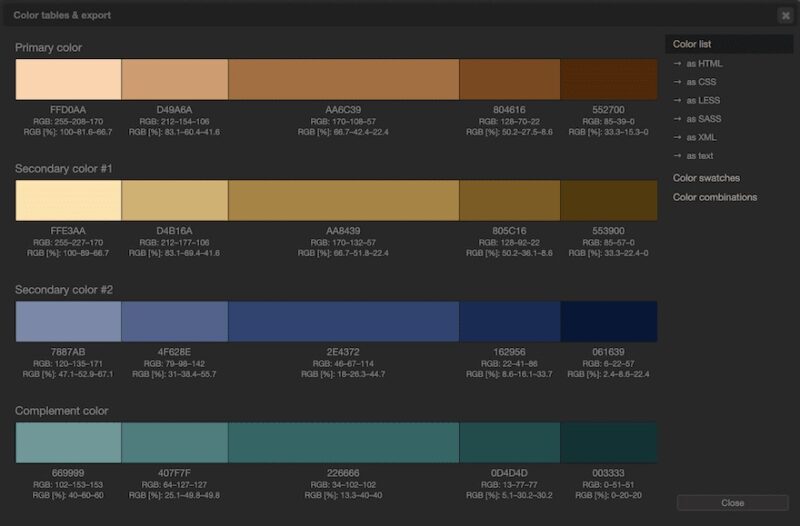
A free online tool for designing colour palettes is Paletton. Its slogan, “In love with colours,” has been in use since 2002.
Designers of all skill levels are encouraged to use Paletton, formerly known as the Color Scheme Designer. It is very accessible and user-friendly, similar to Coolors.
Since its inception, Paletton has developed a highly unique palette to creating colour palettes. It is different from Coolors, which is still honing what makes it distinct despite being excellent.
Paletton places a strong emphasis on an artistic, intuitive approach that enhances the user’s competency while also pleasing them. Decide on a hue that interests you, then go forward.
Utilize the program’s unique colour scheme designer and colour scheme generator to study a variety of potential colour schemes using just one colour. These colour schemes in Paletton are monochromatic, triad, tetrad, complementary, and so on.
Then, you may experiment and create a variety of colour palettes using the one colour you select, your freshly created colour scheme, and Paletton’s colour wheel picker! Although Coolors creates colour palettes as well, it offers much less control over the process.
Not your typical colour wheel, the Paletton Color Wheel is unique. It was instead purposefully designed so that Paletton users of all experience levels could enjoy the palette selecting process and accomplish their colour design objectives.
Paletton’s ability to be utilised in the classroom to educate art and design is one of its strongest characteristics. It’s because of all of its fun yet functional features.
Since users of all skill levels, from experienced designers to inexperienced artists and curious beginners, have control over these functionalities, it is perfect for educating. Enjoy!
2. Gradient Hunt
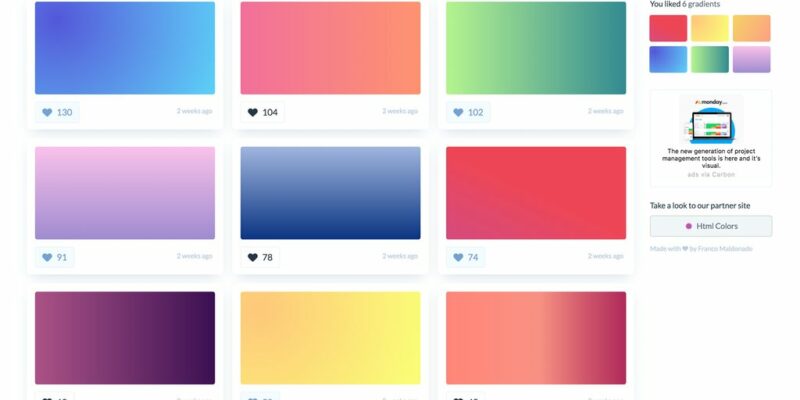
Gradients have become more widely used in design in recent years. Gradient design is consequently growing in acceptance across the board in almost all design disciplines.
Take advantage of this trend with Gradient Hunt. Use it in place of Coolors’ Gradient Maker feature.
If you’re working on a project or piece of design that involves gradients, Gradient Hunt is an excellent resource.
Gradient Hunt is preferable because it was created exclusively for gradient design, even though Coolors’ Gradient Maker is suitable for the majority of gradient design requirements. The “ultimate resource on colour gradients” is what it aspires to be.
Franco Maldonado, a 15-year-old designer and web developer, founded Gradient Hunt in 2018! Even though the two programmes were created by different people, Gradient Hunt’s product design is similar to Color Hunt’s.
For instance, similar to Color Hunt, its open collection includes gradients developed by Gradient Hunt users. The gradients are then maintained and reviewed every day by the founder, Franco Maldonado.
There is also Gradient Tabs, a wonderful Chrome plugin developed by Gradient Hunt. When you add Gradient Tabs to your browser, each time you open a new tab, a random gradient will be displayed from the daily top gradients.
In contrast to Coolors’ Gradient Maker, Gradient Hunt is free. A $3/month Coolors Pro subscription is required to store a gradient on Coolors, though.
For Gradient Hunt, the opposite is true. Gradients can be added for free to your collection.
3. Material Design Palette
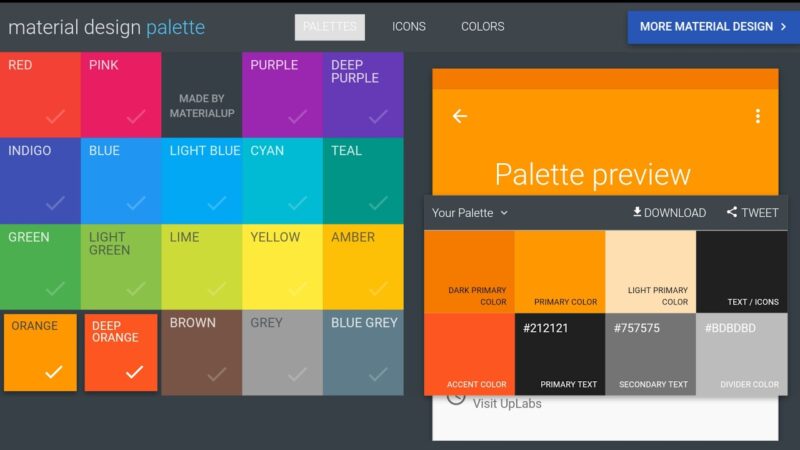
One such palette with a specific focus is the Material Design Palette. Google created the Material Design design system in 2014 to provide structure and consistency to User Interface (UI) design.
The software Coolors is often used for web design, particularly UI design. However, the Material Design Palette is the undisputed winner if you are serious about UI design.
That’s why—the Material Design Palette was created just for Material Design.
Additional palette tools created especially for Material Design are available. However, the Material Design Palette was our choice because it is the best tool to utilise if you want to create a palette from scratch but also require help.
It is simple to operate. Prior to downloading the generated colour palette, pick a primary and secondary colour.
Since there weren’t enough standards, UI design was a disjointed mess prior to the creation of Material Design. Everything was updated with Material Design.
The colours in this palette are strong and bright in accordance with Material Design’s guidelines for UI design in order to create contrast and depth.
Apps and websites for iOS and Android currently support Material Design. It is the most used design design for creating user interfaces.
Utilizing this palette for user interface design makes sense, thus. It is also an excellent alternative for Coolors, which must be adjusted to match particular UI design goals.
Additionally, Material Design Palette is totally free! For a number of its premium services, Coolors nevertheless demands a monthly subscription fee.
4. Pigma
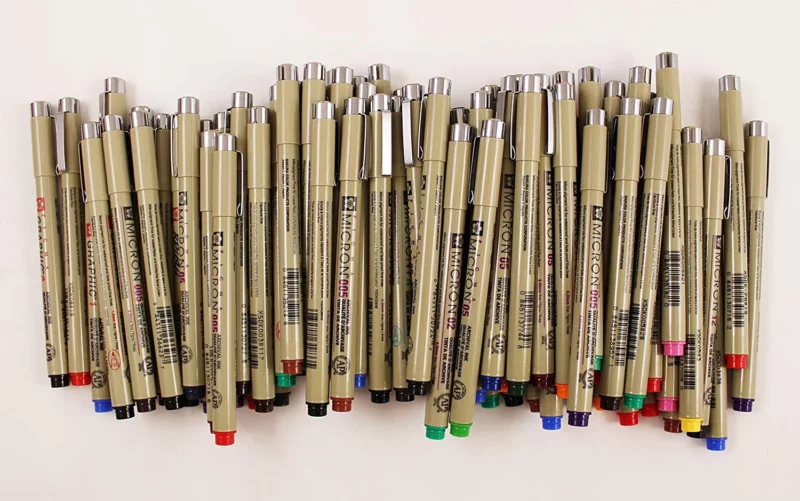
The iOS app Pigma is fantastic. It is a colour selector that can record a true colour for use in art or design.
A similar tool provided by Coolers is Image Picker. You must upload an image from your computer’s desktop or utilise a stock photo in order to use Image Picker.
Since none of these tasks are necessary, Pigma is special. Using the camera on your smartphone, you may capture colours while you’re on the go.
Discover a colour that you enjoy in the actual world. Pigma will display a colour name along with the color’s code and values, such as HEX codes and RGB, when you open the programme and aim the camera at an object.
Starting with a specific colour, you can create as many colour palettes and gradients as you like. If required, colour values are accessible for each section of the gradient.
Gorgeous colour palettes can also be retrieved with Image Picker. The only programme that lets you make gradients is Pigma.
Your colour palettes, colour gradients, or single colour can all be exported from Pigma as a PDF. Another positive feature of Pigma is its database of more than 18,000 colours.
Pigma is accessible in both free and premium editions, depending on in-app purchases. The introductory monthly fee is $0.49.
A lifetime or annual subscription costs about $5.99.
5. IWantHue
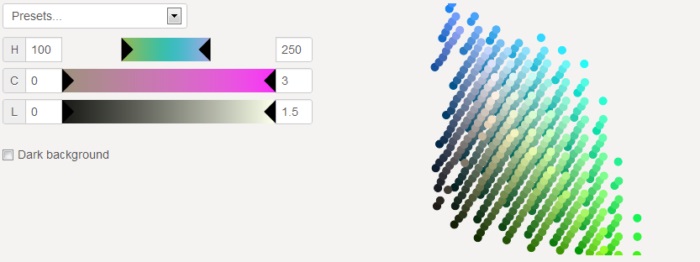
IWantHue is a tool that creates colour schemes specifically for data science. Data visualisation must meet specific criteria for data scientists.
The Coolors programme cannot fulfil these unique criteria because it only has generic capabilities. So iWantHue enters the picture here.
Data science colour schemes must be outstanding, recognisable, and consistent. More important than the aesthetic appeal of the design is the clarity of the final image.
How well does this image communicate? is a question that data scientists who specialise in data visualisation ask frequently. In order to address this, IWantHue was developed.
For example, the colours on a data visualisation graphic must be bright and light since else the content of the image would be obscured. A data scientist can use iWantHue to quickly adjust colour parameters including hue, intensity, and value.
At the Sciences-Po MediaLab, Mathew Jacomy developed iWantHue. The creation of colour palettes with precisely defined hues for the best possible visualisation is given priority by the software.
Numerous unique features that maximise different colour palettes are offered by this Reddit alternative to coolors, including options for color-blind people. A JavaScript code snippet for creating colour palettes for web development projects is also included.
6. COLOURlovers
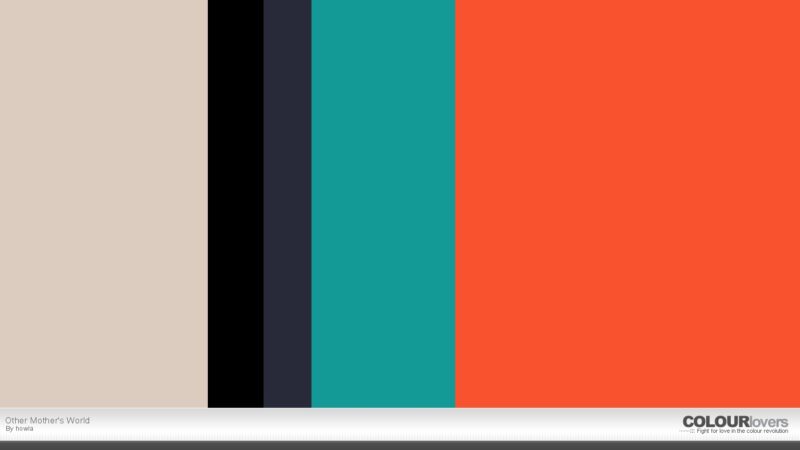
In the lovely online forum COLOURlovers, artists from all around the world discuss artistic concepts, notably colour schemes. It’s a great alternative for Coolors if you’re seeking for a thriving community of design enthusiasts.
On COLOURlovers, you may create, share, and browse palettes. The community can also discuss current creative trends. Although Coolors offers a page dedicated to popular colour palettes, it can come across as cold.
A tool that creates random colour schemes is called Coolors. A database containing hundreds of human-made colour palettes is used by the app algorithm to generate new colour schemes at random.
Although the process at Coolors might be exciting and effective, COLOURlovers provides something unique and more extraordinary. Certain persons can be given credit for the creative concepts that the community has used collectively, including colour schemes.
In such a vibrant creative environment, forming personal connections based on a shared love of art, colour, and design is simple. It makes sense why “All in the spirit of love” is the slogan on the COLOURlovers homepage.
On COLOURlovers, “Color Talk” is a vibrant community where you can share your work and get feedback. There is a forum for crafts, and there are forums for interior design, web design, fashion design, wedding design, and print design.
Additionally, COLOURlovers has websites for numerous channels, groups, trends, and FAQs that are all maintained by the community. Even a blog that is frequently updated is offered!
A sophisticated, cost-free colour palette app is called COPASO by COLOURlovers, which stands for Color Palette Software. However, they offer a simple colour palette for laypeople if you need assistance identifying this tool.
On COLOURlovers, use the PHOTOCOPA tool to create colour schemes based on palettes you prefer. Similar to Coolors’ Image Picker, this feature pulls colour palettes from images.
The creation of colour palettes is the sole function of Coolors. On COLOURlovers, Seamless Lite is a wonderful feature that makes it simple to create seamless patterns (a pattern that can be repeated endlessly).
This generator is a feature to COLOURlovers’ colour palette creation tools. So, for instance, a designer of interior spaces may utilise Seamless Lite to create the right wallpaper using a COLOURlovers colour palette.
7. Adobe Color CC
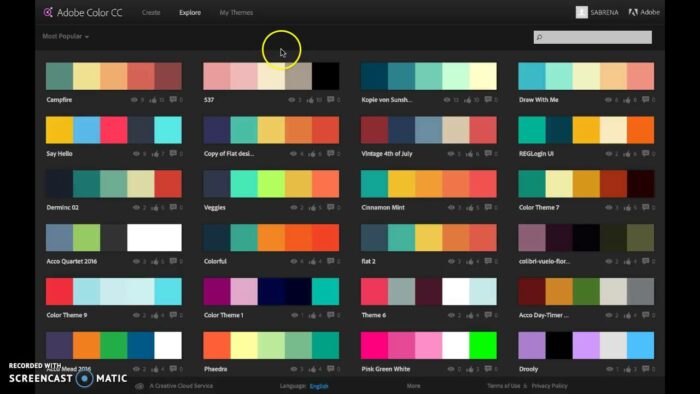
Adobe is a reputable company that designers all over the world regard as the standard for the sector. Over the years, it has published a huge number of digital products.
One of these items, the cost-free web application Adobe Color CC, debuted as Adobe Kuler in November 2006. A colour palette generator, like Coolors, is Adobe Color CC.
The exceptional characteristics that set Adobe Color CC apart from the competition have been kept and improved upon from its early days as Adobe Kuler to the amazing tool it is now.
In contrast to Coolors, Adobe Color CC is free to download from color.adobe.com.
The colour wheel in Adobe Color CC is what sets it apart. Since the app’s creation, it has had this feature, which sets it different from its rivals.
Basic and plain colours are used. But you may make both practical and aesthetic choices when creating your colour palette thanks to Adobe Color CC’s Color Wheel.
For instance, you can adjust the RGB, HSB, and LAB colour models using the Color Wheel. Additionally, you have incredible flexibility when creating your colour palette within the colour models itself because to the functionality of granular HEX colour codes.
The Color Wheel in Adobe Color CC is perfect for creative professionals, design lovers, and committed artists due to its accuracy. Similar to Coolors, this colour wheel also creates color-blind-safe palettes.
Another advantage is that Adobe Color CC is compatible with other Adobe Creative Cloud applications like Photoshop, InDesign, Illustrator, etc.
Coolors was founded in 2014. In contrast to Coolors, Adobe has been around for a long time and has created a wide variety of apps.
For professionals already a part of Adobe’s ecosystem, Adobe Color CC is an excellent choice.
8. Happy Hues
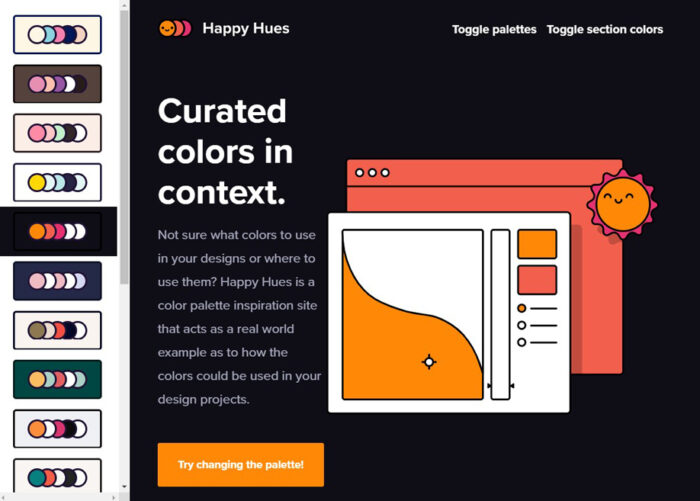
Many design fans would find Happy Hues to be a priceless hidden gem! By allowing you to test it on actual instances, it helps in the discovery of the ideal colour palette.
The Coolors programme is excellent for generating a tonne of random colour palettes. To make palettes with more than five colours and keep more than five palettes, you must pay a $3 monthly subscription fee. It is one of the main disadvantages of the Coolors.
Additionally, paying is required to have the adverts on Coolors’ free edition removed. In contrast, Happy Hues’ web interface is slick, attractive, and cost-free to use.
To utilise Happy Hues, switch through the homepage’s several colour schemes and section colours to see which you like most. The chosen colours can then be copied to the clipboard by clicking on them.
Coolors’ random colour generator might be entertaining, but it can also become addictive. Coolors can’t compete with Happy Hues on this front!
Due of the variety of colours and ease of switching between them, Happy Hues is a pleasure to use. Happy Hues, on the other hand, provides a calming effect as opposed to an addictive one.
9. Color Hunt
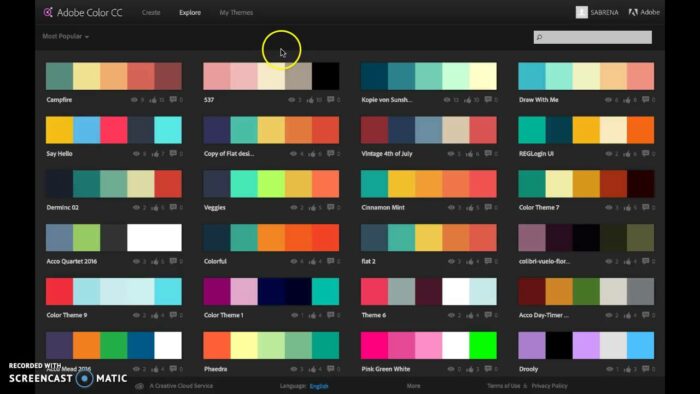
A collection of colour schemes can be found on Color Hunt. Each month, hundreds of thousands of people use this free online resource worldwide.
All artists, designers, and fans of the creative industries can benefit from Color Hunt’s outstanding features. The fact that curators hand-pick each colour palette is what makes it unique, though.
You got it right when you read it: The curators of Color Hunt hand-pick each colour palette from user-submitted images. It has a competitive alternative over Coolors because of this feature. Coolors’ colour palettes are generated randomly from a database and are therefore less well-designed.
In 2015, designer and artist Gal Shir introduced Color Hunt. Color Hunt started as a personal project to help his friends, and despite its rising popularity, it has maintained this warm, intimate feel.
Create and store your colour palettes using Color Hunt’s palette building tool. The public collection will then receive your colour palette.
Every day, the curators manually choose and classify the submitted colour schemes to make sure they belong in the appropriate categories. No claim of ownership is made by either the artist or Color Hunt with regard to any submitted palette.
The Color Hunt curators maintain a mind-boggling 31 categories in which they categorise colour schemes. Pastel, Retro, Vintage, Summer, Skin, Happy, Sunset, Halloween, Wedding, etc. are just a few of these categories.
Hand-selecting colour schemes suggests that the categorisation is incredibly precise. Because they value precision, the categories are essential to artists, designers, and other creative people.
The careful daily curation keeps Color Hunt up to date. This image is also aided by the clean and uncluttered interface of the website.
Coolors, in contrast, lacks a classification scheme.
The colour palette procedure’s selection of the greatest contribution each day is an additional noteworthy feature. It is then displayed on the main homepage the next day.
10. Colormind
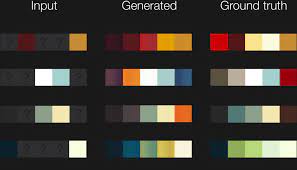
A web-based tool called Colormind uses artificial intelligence to pull colour schemes out of pictures, films, and works of popular art. It uses algorithms from the field of colour quantization, just like the majority of web-based colour palette generators.
However, Colormind offers a unique twist. In contrast to similar web programmes, it gives the final colour palette more weight than preserving the core of the original image.
Colormind and Coolors differ in that Colormind’s colour schemes are frequently more daring and startling while Coolors’s are more muted.
It’s because artificial intelligence (AI), which routinely creates unique colour combinations, creates Colormind’s palettes. As mentioned in this post, Coolors creates random colour schemes using a database that has hundreds of human-made palettes.
Colormind is an excellent alternative if you’re looking for a Coolors substitute. Additionally, Colormind may be utilised with Bootstrap for UI design.
What Is The Best Coolors Alternative, then?
You can choose the alternative that best suits your needs.
If you are using Material Design, select the Material Design Palette. Paletton can be used by art and design instructors. iWantHue is perfect for data visualisation and associated uses. In conclusion, each of these Coolors alternatives is efficient in its own way!
